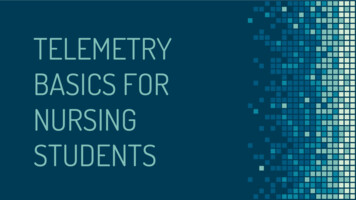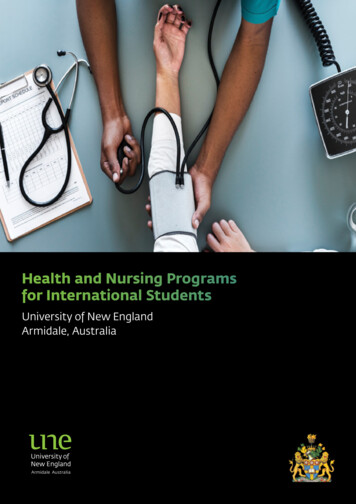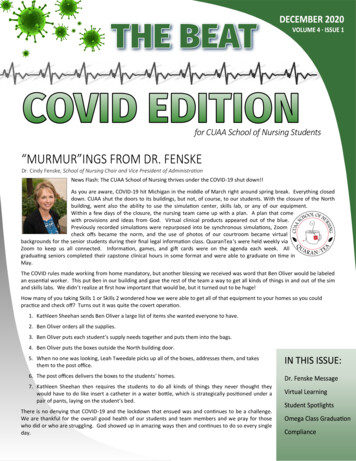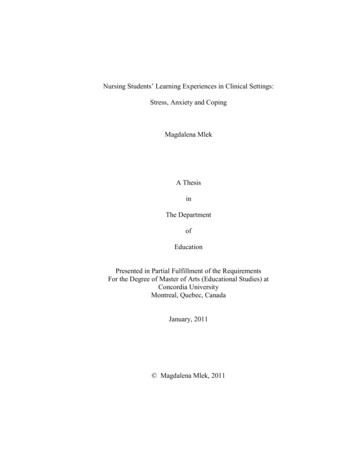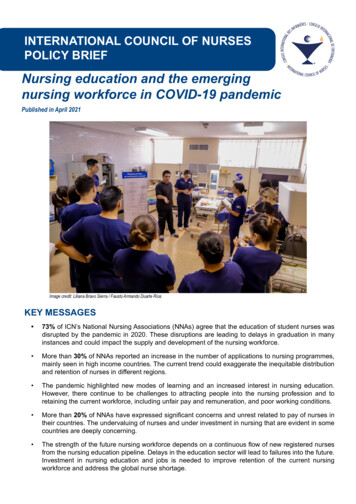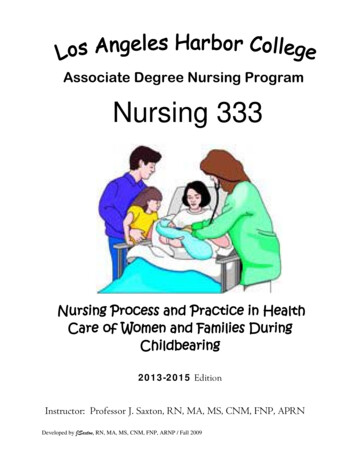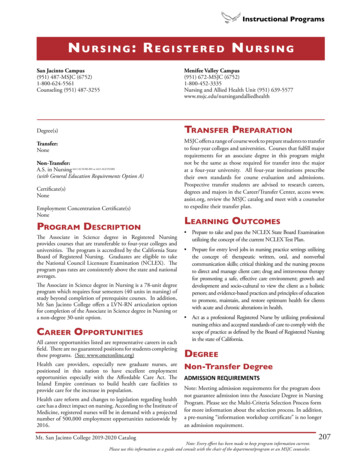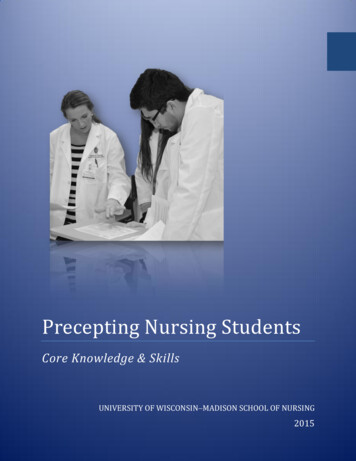
Transcription
Precepting Nursing StudentsCore Knowledge & SkillsUNIVERSITY OF WISCONSIN MADISON SCHOOL OF NURSING2015ldkfjas;ldfkjBo
Copyright 2015 Board of Regents of the University of Wisconsin–SystemPublished by the University of Wisconsin–Madison School of NursingSuggested citation:Precepting Nursing Students: Core Knowledge & Skills. School of Nursing,University of Wisconsin–Madison (2015).About this ResourceThis publication is adapted from a program originally developed at theUniversity of Wisconsin–Madison School of Nursing as a series of onlinecourses. The program was developed under the direction of Susan J. Zahnerfrom course material contributed by nurses with expertise in precepting. Thecourse series was originally developed for online use by Brenda J. Kupsch. Itwas offered in partnership with Continuing Education in Nursing through itsonline learning portal mynursingce beginning in 2005.During 2007-2009 the course series was supported for use by Wisconsinnurses through the Linking Education and Practice for Excellence in PublicHealth Nursing (LEAP) Project funded by the U.S. Department of Health &Human Services, Health Resources & Services Administration, Division ofNursing (Project #D11HP07731).The course material was revised in 2014 by Sara J. Parrell and redevelopedfor online use by Christine A. Lee. It was offered through the mynursingceonline learning portal in partnership with the Center for ProfessionalDevelopment and Outreach at the University of Wisconsin–Madison School ofNursing until 2015.Christine A. LeeDirector for Outreach & Learning Technology
2ContentsPart 1: OverviewIntroduction1)Role of the preceptor2)Strategies for initiating learning partnerships withstudents3)Key questions to ask before beginning to precept4)Summary points5)ReferencesLearning Styles & Teaching Strategies6)Learning Styles7)Methods for assessing learning style8)Teaching strategies for effective student learning9)Summary points10)ReferencesAddressing Challenging Situations11)Student and preceptor stress12)Interpersonal conflict13)Student misconduct14)Summary points15)ReferencesPrecepting Nursing Students: Core Knowledge & SkillsCopyright 2015 Board of Regents of the University of Wisconsin System
3Providing Feedback & Evaluation16)Providing feedback17)Evaluating student performance18)Student feedback to preceptors19)Summary points20)ReferencesPart 2: OverviewTeaching Critical Thinking21)What is critical thinking?22)Strategies for helping students learn critical thinking23)Overcoming student resistance to opportunities tolearning critical thinking24)Indirect strategies for stimulating critical thinking25)Summary points26)ReferencesTeaching Cultural Competence27)What is cultural competence?28)Helping students grow toward cultural and linguisticcompetency29)Working with students from other cultures30)Working with an interpreter31)Summary points32)ResourcesPrecepting Nursing Students: Core Knowledge & SkillsCopyright 2015 Board of Regents of the University of Wisconsin System
433)ReferencesHelping Students Learn Interprofessional Practice34)The Shape of interprofessional practice35)Supporting student learning for interprofessionalpractice36)Strategies to support development of these skills instudents37)Challenges to supporting interprofessional practice whileprecepting38)Summary points39)ReferencesHelping Students Incorporate Evidence into Practice40)What is evidence-based practice?41)What are the steps for EBP?42)Strategies for teaching students43)Summary points44)Resources45)ReferencesAppendix 1: - Kolb Learning Styles and Teaching StrategiesAppendix 2: - Example of Student Misconduct Policies andProceduresAppendix 3: - Weekly JournalAppendix 4: - Example of Final EvaluationPrecepting Nursing Students: Core Knowledge & SkillsCopyright 2015 Board of Regents of the University of Wisconsin System
PART 1: OVERVIEWPART 1: OVERVIEWPURPOSETo develop the knowledge and skills needed to be an effectivepractice-based preceptor for nursing students with a focus on the roleof the preceptor, teaching strategies, addressing challenges, andevaluation.LEARNING OBJECTIVESDefine the role of the nurse preceptor and list characteristics ofeffective preceptorsAssess student learning needs and apply relevant teaching strategiesAddress issues of student anxiety, interpersonal problems, and studentmisconductProvide meaningful feedback and evaluate student performancePrecepting Nursing Students: Core Knowledge & SkillsCopyright 2015 Board of Regents of the University of Wisconsin System
INTRODUCTIONINTRODUCTIONOne of the most effective mechanisms for teaching undergraduatenursing students is the partnering of students with nurses who are inthe role of a clinical preceptor. Since the 1980s it has become acornerstone of clinical nursing education.The preceptorship is a formal one-to-one relationship between astudent and a nurse that extends over a pre-determined length oftime, typically one semester. As a way to bridge theory and practice,and facilitate transition from student to the nurse role in professionalpractice, the preceptor-student partnership is a vital and esteemedcomponent of the educational system.Nurses new to the role of preceptor share concerns about taking onthe challenge and responsibility of supporting and guiding theeducation of a student. Understanding the role components andaddressing key questions related to agency and school of nursingpolicies and procedures is critical to role satisfaction and a successfulpreceptorship.1) ROLE OF THE PRECEPTO RSchools of nursing enlist clinical organizations with a commitment toclinical nursing education to teach student nurses via the role thenurse preceptor, a professional nurse employee of the organization.Being a preceptor can be an extremely rewarding experience(Omansky, 2010): Preceptor achievements and expertise are acknowledged. Participating in student improvement in critical thinking,problem-solving, clinical judgment and skills, setting priorities,and self-confidence provides a sense of accomplishment. Preceptor’s commitment to the future of nursing is validated.Precepting Nursing Students: Core Knowledge & SkillsCopyright 2015 Board of Regents of the University of Wisconsin System
INTRODUCTION Preceptorships provide a pathway for professional development. Affiliation with an academic institution provides contact withfaculty, and often access to library resources, ongoingprofessional advancement classes, and other resources.The success of the preceptorship is determined by the strength of therelationship between the student and professional nurse preceptor.Preceptors, in turn, benefit from the support of clinical faculty in theschool of nursing and their supervisors at work (Happell, 2009).GENERAL FUNCTIONS OF THE PRECEPTOR ROLEServe as a role model, illustrating the nursing interventionsappropriate to the agency.Precepting Nursing Students: Core Knowledge & SkillsCopyright 2015 Board of Regents of the University of Wisconsin System
INTRODUCTION Move student from shadowing experiences to taking onincreased responsibility for the care of clients, groups andcontributing to projects. Supervise and validate student actions, observations anddecisions. Expose student to the “big picture” of the organization and ofprofessional practice in the community of care where thelearning opportunity occurs.Design opportunities for students to become directly involved in clientand population care, and agency activities. Assist students to define learning goals and structure theirclinical experiences. Review the competencies of students with the activities of theagency to mold the experience to fit the needs of the studentsand the health agency. Make connections to unique learning opportunities within theagency. Guide the student in identifying and locating resources anddemonstrate and inquiring attitude and best practice.Evaluate student learning needs and provide feedback regardingclinical progress. Use active listening and verbal skills that build trust andencourage strengths. Give feedback in a timely fashion, offering suggestions for thefuture.Facilitate the student’s socialization into the role of the nursePrecepting Nursing Students: Core Knowledge & SkillsCopyright 2015 Board of Regents of the University of Wisconsin System
INTRODUCTION Be aware that socialization is an interactive process thatproduces the attitudes, skills, values and knowledge required toparticipate effectively in the profession of nursing. Lead by example and introduce students to colleagues whoinspire you. Include the student in activities that highlight the professionalrole of the nurse, including interprofessional processes.In a study of 214 students rating clinical teachers,effective teachers received high scores for professionalcompetence, interpersonal relationship, personalitycharacteristics, and teaching ability. Larger differences inscores between ineffective and effective teachers werefound in the interpersonal relationship category. Theseresults indicate that teachers’ attitudes toward studentmay be the crucial variable in a successful teachinglearning experience (Tang, et. al., 2005)2) STRATEGIES FOR INITIATING LEARNINGPARTNERSHIPS WITH STUDENTSProviding an optimal experience for students and preceptors takescareful planning. Preparation for the clinical placement is shared by theeducational facility, the preceptor, and the student. Some agencieswith large numbers of preceptors create a coordinator role thatincludes responsibility for preparing for the entry of students into theagency.Precepting Nursing Students: Core Knowledge & SkillsCopyright 2015 Board of Regents of the University of Wisconsin System
INTRODUCTIONONE TO TWO WEEKS BEF ORE THE STUDENT ARRIVES1)Receive student and course faculty name(s) and contactinformation2)Communicate with student regarding first day expectations(dress, meeting location and time, likely activities, parking,etc.)3)Review the HIPAA policy of the school in relation to youragency’s policy4)Inform student of agency-specific requirements (e.g.,background check)5)Receive and review the course syllabus6)Gain an understanding of the course learning objectives7)Alert agency director and staff regarding the student role andschedule8)Identify and enroll other agency staff who are willing to be aresource for students9)Identify a work space for the student at the agency site,including computer access10)Plan first-day orientation activities11)Contact agency preceptor coordinator and/or courseinstructor with any questions or concernsFIRST DAY OF THE PRE CEPTORSHIPThe first encounter between preceptor and student is a powerfulopportunity for setting the course for a rich teaching and learningexperience.1)Warmly welcome the studentPrecepting Nursing Students: Core Knowledge & SkillsCopyright 2015 Board of Regents of the University of Wisconsin System
INTRODUCTION2)Ask student for information regarding learning style, previousclinical experiences, and personal learning goals (someschools of nursing will require students to provide a skillinventory, professional profile including work and clinicalplacement history and/or preferred learning styles)3)Review with student: learning objectives, assignments,student and preceptor evaluations4)Clarify schedule and expectations for number of hoursrequired for completion of clinical5)Share information about the agency’s mission, work, andorganizational structure6)Share your expectations for the student’s role in the agency7)Introduce student to key staff and other resources; provide“tour” of the agency8)Provide information on parking, space for coat/equipment,wearing ID, phone and computer policies, expectations fordocumentation of care, work day expectations includingprovision for lunch9)Share expectations for feedback and communication: preand/or post-conferences, use of weekly journal or othercommunication tool, contact between weekly clinical dates,etc.10)Encourage open, ongoing communication11)Assure student of the opportunities to achieve course andpersonal learning objectives within the agency with yoursupport12)Contact agency preceptor coordinator and/or courseinstructor with any questions or concernsPrecepting Nursing Students: Core Knowledge & SkillsCopyright 2015 Board of Regents of the University of Wisconsin System
INTRODUCTION3) KEY QUESTIONS TO ASK BEFORE BEGINNING TOPRECEPTWhat is the best way to contact a student? A clear communication system should be set up to ensure apositive overall teaching-learning experience. Describe the preferred way to be contacted (email, work phone,cell phone, voicemails, texts) and any guidelines for clientconfidentiality related to messaging. Set clear guidelines and expectations for communication duringand between clinical days. Students are responsible for timely communication regardingplanned and unplanned absences and tardiness. Contact course faculty for any concerns regarding studentcommunication or attendance.What does the student need to do to complete the course? Understand course objectives, assignments and grading criteriaas provided by the course faculty and seek sharedunderstanding with the student. Ask for information about how the course fits into the generalundergraduate nursing curriculum, if needed.Will I be held liable if the student does something wrong? Often, liability for student actions while on assignment toagencies for clinical education is the responsibility of the schoolor larger college or university in which the nursing programexists.Precepting Nursing Students: Core Knowledge & SkillsCopyright 2015 Board of Regents of the University of Wisconsin System
INTRODUCTION Schools of nursing have written agreements (or contracts) withagencies providing preceptorships; information about liability ifoften included in those documents; preceptors may review thisagreement. If a student does anything in the agency that could possiblyresult in a liability claim, the supervisor and course facultyshould be contacted; document the details of the situation.What are my responsibilities if a student is injured while at theagency? Injuries are uncommon and can result from clinical activities(e.g., needle stick) or personal injury on site (e.g., a fall, caraccident while on a home visit). Assist the student as needed and contact the agencycoordinator/supervisor and the course faculty. Follow agencyand school of nursing policies and procedures (provided to youby course faculty). Injuries involving blood or body fluid exposure are of particularconcern, and prompt support using the agency procedure shouldbe followed.Is the student HIPAA compliant? All students in schools of nursing are required to learn and abideby the Health information privacy requirements of the HealthInsurance Portability and Accountability Act (HIPAA). If the clinical agency has additional requirements, the studentwill be required to meet those. Contact course faculty for any questions regarding the specificinstruction students have received on HIPAA.Precepting Nursing Students: Core Knowledge & SkillsCopyright 2015 Board of Regents of the University of Wisconsin System
INTRODUCTIONIs a criminal background check completed for a student? Not all schools of nursing require students to complete acriminal background check. If the clinical agency requires this, communication with thecourse faculty and student is important to clarify the status ofthe student.Is the student a mandatory reporter of suspected abuse? Most students will have been informed that they are required bylaw to report suspected abuse. Orient the student to agency policies on reporting, clarify theirunderstanding of their responsibilities in the arena, andreinforce the need for the student to inform the preceptor ofconcerning situations.Have students had required immunizations and tuberculosis tests? Documentation of immune status is typically required by schoolsof nursing at the time of admission. Documentation oftuberculosis status is often required annually. Contact course faculty for specific questions and verification ofschool policy if you have concerns.Does the student know CPR? Schools of nursing are careful to keep students up-to-date onCPR certification. If the agency requires documentation of the date, contact theschool and/or ask the student for verification.Precepting Nursing Students: Core Knowledge & SkillsCopyright 2015 Board of Regents of the University of Wisconsin System
INTRODUCTIONIs the student required to wear a uniform? Uniform policy varies by school and clinical agency. Make expectations clear to students in advance of the first dayof clinical, and address any concerns as they arise. Special security or identification procedures should be addressedin advance by contacting course faculty and the student.What is the length the clinical preceptorship? Academic calendars vary by institution and clinical courses mayor may not follow the traditional semester calendar. Clarify with the course faculty or through the syllabus when thefirst day and last day of clinical instruction occur and any breaksor holidays. Keep in mind the number of clinical hours required by the schoolwhen altering student schedules.What is the student expected to do in the event of bad weather orproblems with transportation? Discuss in advance any agency policies on weather closures. Students traveling to clinical sites where public transportation isnot available are typically required to provide their own reliabletransportation (personal vehicle, rental car, etc.). Students are instructed to contact their preceptor or agencywhen their absence is essential; it is the student’s responsibilityto makes arrangements for any missed clinical time.What support is available to me in precepting students?Precepting Nursing Students: Core Knowledge & SkillsCopyright 2015 Board of Regents of the University of Wisconsin System
INTRODUCTION Schools of nursing vary in ways they support preceptors;communicate with the course faculty about specific formal andinformal supports and incentives available to you. Supports may include: financial reimbursement or non-budgetedappointments, access to campus resources (e.g., library,recreational facilities), journal subscriptions, professionaldevelopment meetings or courses. Course faculty should be available for consultation at all timesand for on-site visits when more in-depth information sharing orproblem-solving is indicated.4) SUMMARY POINTS Preceptors serve as role models for nursing students for nursinginterventions and activities appropriate to clinical courseobjectives. Preceptors assist students in defining learning goals andstructuring learning experiences. Preceptors help nursing students become socialized to the roleof the professional nurse. Being a preceptor requires advanced planning and preparation. Being a preceptor for nursing students is a rewardingexperience. Communication and ongoing consultation with clinical coursefaculty is important to a successful preceptor-studentpartnership.Precepting Nursing Students: Core Knowledge & SkillsCopyright 2015 Board of Regents of the University of Wisconsin System
INTRODUCTION5) REFERENCESHappell, B. (2009). A model of preceptorship in nursing: Reflecting thecomplex functions of the role. Nursing Education Perspectives (30)6,372-376.Omansky, G.L., (2010). Staff nurses’ experiences as preceptors andmentors: An integrative review. Journal of Nursing Management (18),697-703.Tang F.I., Chour S.M., Chiang, H.H., (2005). Students’ perceptions ofeffective and ineffective clinical instructors. Journal of NursingEducation (44)4, 187-192.Precepting Nursing Students: Core Knowledge & SkillsCopyright 2015 Board of Regents of the University of Wisconsin System
LEARNING STYLES & TEACHING STRATEGIESLEARNING STYLES & TEACHINGSTRATEGIESStudents learn best when the teaching strategy employed bestmatches the person
This publication is adapted from a program originally developed at the University of Wisconsin–Madison School of Nursing as a series of online courses. The program was developed under the direction of Susan J. Zahner from course material contributed by nurses with expertise in precepting. The

